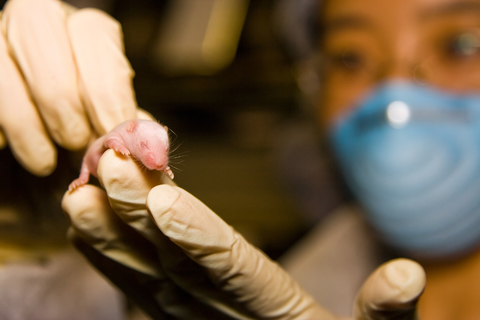Mice with 3D printed ovaries give birth

3D printed ovaries made of gelatine have allowed mice to conceive and give birth to healthy pups (Science, 2017). Engineered ovaries like these could one day be used to help restore fertility in cancer survivors rendered sterile by radiation or chemotherapy.
This “landmark study” is a “significant advance in the application of bioengineering to reproductive tissues” said Mary Zelinski, a reproductive scientist at the Oregon National Primate Research Center in Beaverton who was not involved with the research.
The researchers used a 3D printer with a nozzle that fired gelatine, derived from the collagen that’s naturally found in animal ovaries. The scientists built the ovaries by printing various patterns of overlapping gelatine filaments on glass slides. Each scaffold measured fifteen by fifteen millimetres. The team then carefully inserted mouse follicles (spherical structures containing a growing egg surrounded by hormone-producing cells), into these scaffolds. The scaffolds that were more tightly woven hosted a higher fraction of surviving follicles after eight days, an effect the team attributes to the follicles having better physical support.
The researchers then tested the more tightly woven scaffolds in live mice. The researchers punched out two millimetre circles through the scaffolds and implanted forty to fifty follicles into each one, creating a bioprosthetic ovary. They then surgically removed the ovaries from seven mice and sutured the prosthetic ovaries in their place. The team showed that blood vessels from each mouse infiltrated the scaffolds. This vascularisation is critical because it provides oxygen and nutrients to the follicles and allows hormones produced by the follicles to circulate in the blood stream.
The researchers allowed the mice to mate, and the team reports in Nature Communications that three of the mice gave birth to healthy litters. They also lactated naturally, which demonstrated that the follicles embedded in the scaffolds produced normal levels of hormones.
The team is hopeful that similar bioprosthetic ovaries can be implanted in humans to restore fertility, using a patient’s own previously extracted follicles or donated samples. But that is a long way off. Ovarian scaffolds for humans will need to be specifically designed to host blood vessels because of their larger size, a challenge any large printed body part will have to overcome, said Nicolas Sigaux, a surgeon focused on medical applications of 3D printing at the Lyon-Sud Hospital Center. “Vascularization is the main limitation to printing large pieces of functional tissue.” He said once this problem is solved, ready to implant organs should be possible with 3D bioprinting.








